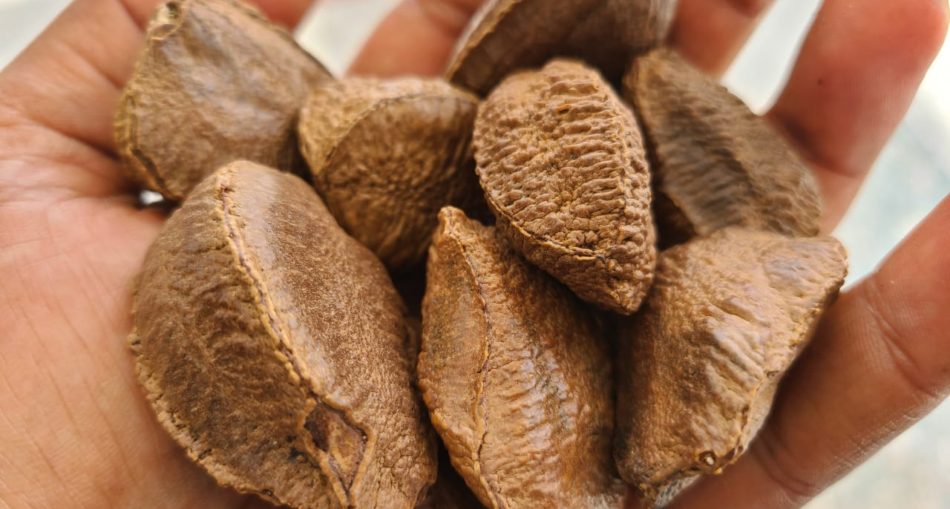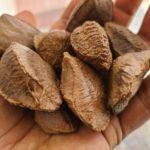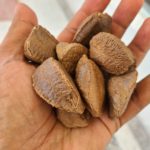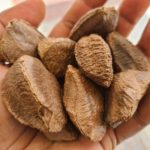The Brazil Nut is among the largest trees in the Amazon Rainforest, typically growing among the scattered trees. While the tree is noted for its nut, a legume packed with nutrients and many health benefits, it produces high-quality wood which is illegal to log in some countries. The nuts from these trees are harvested almost exclusively from wild trees which are over five hundred (500) years old in pristine forests.
The scientific name of the Brazil Nut is Bertholletia excelsa but it is commonly known by several names. For example, while its indigenous name is juvia, in Bolivia it is called castañas de Brasil, nuez de Brasil, or castañas de Pando. It is also known as castanhas-do-pará or castanhas-do-acre in Brazil, depending on the area and in Cuba it is called coquito de Santiago, meaning St. James coconut.
Origin of The Brazil Nut
The Brazil Nut (Bertholletia excelsa) is native to few South America in countries including Bolivia, Brazil, Columbia. French Guiana, Guyana, Suriname, and Peru. It can be found along the banks of the Amazon River, Esmeraldas, Rio Negro, Tapajós, and the Orinoco.
Scientific Classification of The Brazil Nut
- Kingdom: Plantae
- Clade: Tracheophytes
- Clade: Angiosperms
- Clade: Eudicots
- Clade: Asterids
- Order: Ericales
- Family: Lecythidaceae
- Subfamily: Lecythidoideae
- Genus: Bertholletia
Bonpl. - Species: B. excelsa
Description of The Brazil Nut
The Brazil Nut is one of the largest trees in the Amazon rainforest, reaching heights of one hundred and sixty (160) ft tall with a trunk around one to two (1-2) m in diameter. The tree has a straight stem and lacks branches until about midway of the height of the tree, forming a large crown of branches. The bark of the Brazil Nut is smooth and grey in colour. Its leaves are oblong, alternate with scalloped edges, about twenty to thirty-five (20–35) cm in length with widths of ten to fifteen (10–15) cm. The plant has small, greenish-white flowers are about five to ten (5–10) cm in length, uneven cream petals, two-parted deciduous calyx, and many stamens joined in a wide, hood-like mass. The fruit of the plant is a large pod, about ten to fifteen (10–15) cm in diameter with hard woody shells, almost like coconuts. Weighing up to 2 kg, the capsule contains eight to twenty-four (24) wedge-shaped seeds. These seeds of the Brazil Nuts are around four to five (4–5 cm) and are clustered like an orange with up to three layers of whorls.
- Brazil Nuts – Photo By Girendra Persaud
- Brazil Nuts – Photo By Girendra Persaud
- Brazil Nuts – Photo By Girendra Persaud
Nutrition Facts of The Brazil Nut
Per one ounce (28 g) of Brazil Nut contains 187 Calories, 19 g Fat, 0.9 mg Sodium, 3.3 g Carbohydrates, 2.1 g Fibre, 0.7 g Sugars and 4 g Protein.
Interesting Tip
- One ounce (28 g) of Brazil Nuts is equivalent to six (6) nuts.
Health Benefits of The Brazil Nut
- Improves bodily functions – Brazil nuts contain large amounts of selenium, a trace mineral which strengthens the immune system and improves conditions like heart disease, infections, infertility and cancer, including a healthy thyroid. Selenium in the Brazil Nut can also help to reduce your risk of Hashimoto’s disease, Graves’ disease, and thyroid cancer.
- Reduces Risk of Heart Disease – Monosaturated fats or healthy fats found in Brazil Nuts can help to improve cholesterol levels, which in turn reduces the risk of heart disease. Additionally, the fibre found in these nuts can help lower blood cholesterol levels hence reducing risks of heart disease and stroke.
- Aids in Diabetes Management – Selenium, may also help people with type 2 diabetes by lowering insulin levels in the body, boost insulin sensitivity, and improving blood sugar levels.
- Relieves Inflammation – Antioxidants found in Brazil Nuts fight free radicals, and reduce oxidative stress. It also helps to lower inflammation which in turn reduce the risk of health conditions.
- Bone Health – The nuts also contain large amounts of calcium and magnesium, which are necessary for high bone density.
- Brain Health – Brain health can be boosted by the consumption of Brazil Nuts due to their antioxidants and selenium, they contain.
Culinary Uses of The Brazil Nut
- Brazil Nuts can be eaten raw or roasted.
- The first extraction of oil from Brazil Nuts is used to cook with.
- Brazil Nuts are used to make Brazil Nut cake, a common dish in Brazilian cuisine.
Other uses of The Brazil Nut
- The Brazil Nut produces high-quality lumber which can be used for flooring or even heavy construction. However, the logging of the trees is prohibited by law in Brazil Bolivia and Peru.
- The second extraction of oil from the Brazil Nuts are used as a lubricant in clocks, in the manufacturing of paint, and for cosmetics.
- The Brazil nutshells are believed to be engraved by indigenous tribes in Bolivia and used as jewellery.
- The nutshell of Brazil Nuts can be crushed and used to polish materials such as metals and ceramics due to its hardiness.
About The Brazil Nut
The Brazil Nut trees can live for over five (500) hundred years, even reaching one thousand years of age. The Brazil Nut is not popularly consumed locally since it is only produced and exported by a few countries. However, it is rich in antioxidants and selenium which can help improve the overall functioning of your immune system and body.
Article References
- https://en.wikipedia.org/wiki/Brazil_nut
- https://www.researchgate.net/publication/301982002_Bertholletia_excelsa
- https://www.webmd.com/diet/health-benefits-brazil-nuts#1
- https://www.healthline.com/nutrition/brazil-nuts-benefits#TOC_TITLE_HDR_9
- https://www.verywellfit.com/brazil-nut-nutrition-facts-calories-and-health-benefits-4114227
- https://www.botanical-online.com/en/food/brazil-nuts-oil#:~:text=Brazil%20nuts%20oil%20is%20an,nut%20tree%20(Bertholletia%20excelsa%20Humb.&text=Brazil%20nut%20oil%20is%20rich,properties%20to%20beautify%20the%20skin.
Discover more from Things Guyana
Subscribe to get the latest posts sent to your email.










